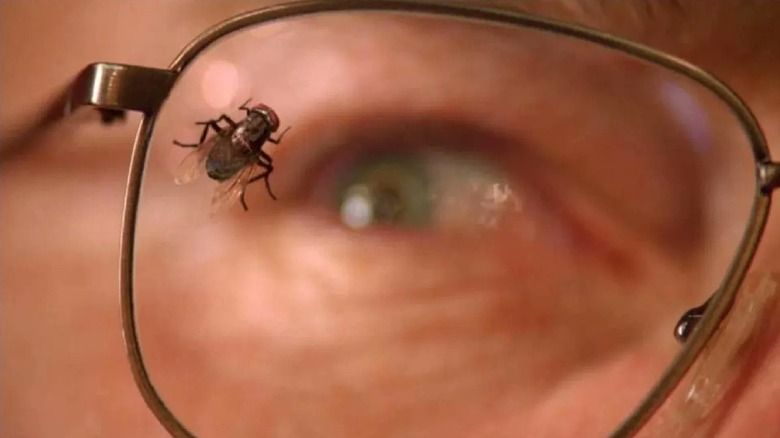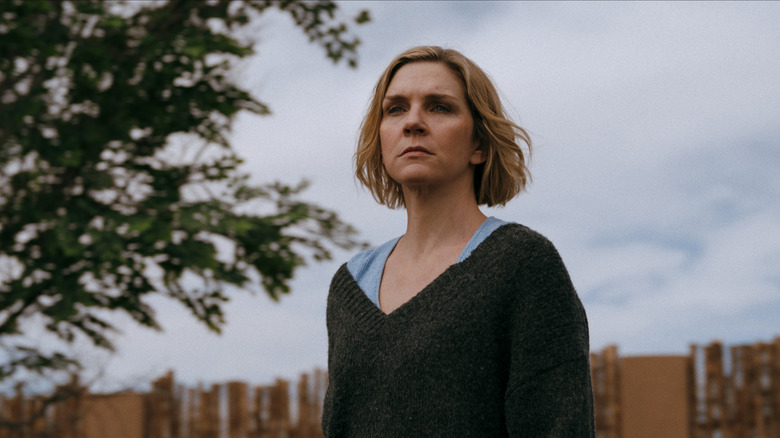One Key Moment In Pluribus Episode 5 Might Have A Deeper Meaning For Breaking Bad Fans
Warning: This article contains spoilers for episode 5 of "Pluribus."
If there's one thing we've learned from "Pluribus" so far, it's that you never know exactly what you might be in for during any given episode — whether it be a pleasure-seeking hedonist setting up his own harem during the end of the world, a fun cameo from the actual mayor of Albuquerque, or a particularly stubborn pack of coyotes (long considered New Mexico's unofficial state animal) that might symbolize something much deeper than you think. The very premise of the Apple TV series allows for no end of haunting visuals and imagery, unconstrained by anything except the limits of our imagination (or, more accurately, that of creator and writer/director Vince Gilligan). When dealing with a story depicting what might as well be the downfall of the human race, after all, it stands to reason that the direction would evoke some unexpected or even disturbing feelings.
But, at a time when even "Pluribus" has fallen prey to overly-literal thinking and perhaps some waning attention spans, there's something admirable about the show keeping certain aspects unsaid or, at the very least, left as subtext. For instance, take the recurring appearances of those coyotes in episode 5, titled "Got Milk." On the surface, they serve a pretty straightforward plot function: to further highlight Carol Sturka's (Rhea Seehorn) loneliness and paranoia in the wake of the hive mind's abrupt departure (they needed "a little space," is all) and indirectly lead her to that episode-ending cliffhanger about what the hive mind is really up to far from prying eyes. Underneath, however, we get the sense there's something much more meaningful going on — and it ties together nicely with one of the most divisive episodes in all of "Breaking Bad."
The coyotes in Pluribus play a similar role as the fly in Breaking Bad
Yes, we know, not everything in "Pluribus" is analogous with "Breaking Bad" or "Better Call Saul" ... but walk with us on this one anyway. After Carol wakes up one night to the sound of something making a ruckus outside, the reveal that it's "only" coyotes raiding her garbage cans does little to assuage the unsettling vibes in the aftermath of her becoming the only individual currently residing in Albuquerque, New Mexico. When the pack returns and sets its sight on the makeshift grave of Carol's business partner and lover Helen (Miriam Shor), Carol the lone survivor transforms abruptly into Carol the angel of vengeance. When the smoke clears (you know, from driving an entire police car through her backyard fence), the coyotes scatter and allow her to build a proper tomb — but what if we took those pesky canines beyond face value?
This can't help but bear a striking resemblance to "Breaking Bad," when Walter White (Bryan Cranston) finds himself tormented by another, more irritating member of the animal kingdom. "Fly" stands as one of the more underrated episodes of Vince Gilligan's previous series, but its true genius comes from treating that annoying insect as something more. At that point in Walt's arc, he's finally forced to reckon with the full scope of his actions — the death of Jane (Krysten Ritter), the subsequent plane crash, and the effects this continues to have on Jesse (Aaron Paul). In a twist taken straight out of classic Greek tragedy, the fly isn't just a fly, it's a physical manifestation of his infinitely deep reservoirs of guilt and anger.
Take a deeper look at Carol's emotional state, and viewers will see some fascinating parallels.
Pluribus is quietly focused on Carol's unresolved grief
Although not quite as bluntly depicted as in "Breaking Bad," "Pluribus" takes an equally compelling approach to dropping viewers into Carol's headspace in "Got Milk." The sci-fi series has the added distraction of dealing with the main mystery behind the show's ongoing plot, but there remains one vastly important character trait simmering in the background of practically every episode: Carol's unprocessed and unresolved grief in the wake of Helen's death. It's no coincidence that the series keeps returning to this well, either through flashbacks (like their uncomfortable excursion to the iciest hotel on Earth in episode 3) or through more straightforward means as shown here.
So, when are coyotes not just coyotes? When they're acting as signposts directing Carol towards the root cause of all her outbursts and anger and loneliness. It's why the episode (directed by "Breaking Bad" veteran Gordon Smith and written by "Better Call Saul" scribe Ariel Levine) spends as much time as it does on her quest to haul all those stone slabs back to her backyard and give Helen a proper burial. It's not the main priority of the hour, of course — that honor goes to Carol stubbornly unraveling the questions at the heart of the hive mind and whatever gasp-inducing revelation she arrives at in the final moments. But for a show that could've easily coasted on the potential of its premise alone, it's heartening that Vince Gilligan and his writing team know that all the mystery-box storytelling in the world amounts to nothing without a complex protagonist carrying enough emotional baggage to stop an entire hive mind in its tracks. It just took a few meddling coyotes to bring that message home.
New episodes of "Pluribus" stream on Apple TV every Friday.


